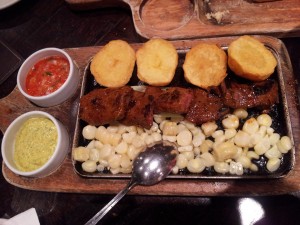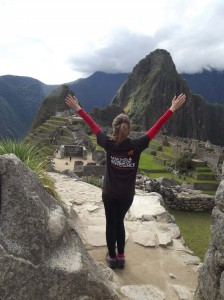Kaya staff all have a passion for travelling and experiencing the countries we send volunteers to, so that we have the best first hand advice to offer you. My name is Sarah Brown, marketing coordinator, and I’m keen to share my recent experiences to those looking to volunteer in Peru!
At Kaya we put emphasis on volunteering as a cultural exchange, not only putting work into your projects. At the end of your project you should feel like you have learned about the history, the people, the cuisine and anything else you can about the country you call home during your volunteering. Here are a few things I learned during my time in Peru.
Many volunteers doing a project in Cusco, will fly into Lima and then connect. Although there are safety considerations, I found Lima to be a beautiful place, and providing you stay in popular hostels and check the reviews first, (preferably with a friend), you should be fine to explore a little before or after your project. Being the capital city, Lima says a lot about the rapid development of Peru over the last few years. The best place to be is the young, contemporary and beach-side Miraflores, that has everything from backpacker bars and restaurants, to more up-market (and still very reasonably priced) dining spots.
I wouldn’t advise you to travel too far outside of Miraflores as you enter the less touristy areas, in which your safety isn’t as guaranteed. Either stick to walking around Miraflores, or take organised tours recommended by the hostels. Don’t risk taking a bus or taxi if possible, but if you do need to take a taxi, ask the hostel or hotel to call one for you, and never trust one you flagged down!
Depending on your budget, there are also a lot of great things to do in Lima. Paragliding above Miraflores coast was a highlight for me. Also, if you’re well accustomed to Spanish, there are some great outdoor plays around the city, and the Contemporary Art Museum (MAC) is also worth a visit, for a small entrance fee. Miraflores is also a big spot for surfing, if that floats your boat. Finally, if you are looking to give Lima a go, an absolute must for me is the fountain park downtown, a huge variety of fountains with a light show at night, definitely helps you appreciate the romantic side of Peru.
Peruvians are very proud of their cuisine, and any Peruvian will gladly hand you a fork and direct you to the nearest Ceviche (fish stew), Lomo Saltado (sauteed tenderloin) or Anticuchos (Cow Heart). Now I hear you say that doesn’t leave much for vegetarians, however Peru has a wealth of home-grown vegetables, including over 3500 types of potatoes, and the softest avocados I’ve ever eaten! The flavours are unlike anything I’ve had before, and due to the fact that Peruvian cuisine is quite rare in Europe, you should definitely dive in and try as much as possible!
If you’re feeling more flash, or perhaps as a reward after your volunteering, celebrity chef Gaston Acurio owns a chain of restaurants called “Tanta” and “Panchita” (Panchita being more expensive of the two), where you can find reasonably priced top rated cuisine. These chains are not yet in Cuzco, but you can find lots of sellers of the street food Anticuchos, and if you’re feeling very brave, a delicacy called “Cuy” (or guinea pig to you and I).
I wouldn’t be an honorary Peruvian without mentioning alcohol! The national drink Pisco, is whipped up and mixed with pretty much anything, and various cocktails can be found in any bar, including the famous “Pisco Sour” and my personal favourite “Chilcano”, but go sparingly, it is delicious but strong.
Cuzco, where the majority of our projects are based is a charming little town near the Andes, and is at a higher Altitude. I had no problems in that department but people are affected differently. Avoid too much alcohol, and avoid eating too late at night and you should be fine. You can also try drinking the local “Coca tea” which is known to help with the symptoms. The people in Cuzco are more traditionally dressed, and you will see the poorer side of Peru, including Shanty towns extending over the mountains in the background and more street side sellers. They are safe to buy from but make sure you have small notes (10, 20 soles), as they rarely have change.
Volunteers looking to go during the summer or during University holidays should be aware that it’s not very hot, as it is their winter, and in Cuzco at night it can fall to 3-4 degrees. However, the old Peruvian remedy of the Alpaca blanket should sort that out, which you can pick up at the local markets, and fall in love with! During their summer temperatures reach mid twenties, but never too extreme.
Going during summer months is also an advantage because you will catch the Festival of the Sun (Inti Raymi) at the end of June. The main plaza is packed to capacity with locals dancing and parading in the street, in colourful costumes and dancing to traditional music played on stage. Each night is closed by huge firework displays, and I heard parties outside my room until at least 4am!
Finally, of course the number one thing to do in Peru if you have time: Machu Picchu. It was everything I imagined…and more! The Peruvians are extremely proud of their heritage, and this world heritage site originally built by the Incas, has given them a big tourism boost as interest has peaked in recent years. Because it’s a UNESCO site it’s still perfectly preserved, with some of the greenest and best kept grass I’ve ever seen, which explains why all my photos look photo-shopped (believe me, it’s all real).
There are two options on how to get to Machu Picchu, as it is a little way out of the town of Cuzco. You can do a trek, which usually takes four days and is done in a group of backpackers and includes camping overnight. However, if you wanted to visit during one of your weekend breaks in between volunteering, the train is a better option. I did this, and booked the train with Peru-rail. The journey duration can be slightly unpredictable, but it is a smooth journey, with amazing views and it takes you right into Machu Picchu town. This is a small collection of markets, restaurants and little hostels nestled into the valley, some people like to stay there overnight, but you can make it back in the same day as I did. Here in the town (literally a 5 min walk from the station) you need to find the bus station and get a $12 return ticket up the mountain to the actual site. It winds its way up, giving you some amazing views and when you arrive it’s around a $35 entrance fee – trust me it’s well worth saving your pennies.
Once inside, you can take a guided tour, walk around, take pictures and even spot some alpacas casually chilling right next you!
Overall, although the main aim of our projects is to contribute to the project you choose, don’t dismiss the benefit that tourism provides to the country in general, and that learning as much as you can about your host country helps to develop culturally aware global citizens, and gives you some great stories to boot. Those looking to volunteer in Peru can find out about this and more by speaking to a Kaya advisor.
Happy Volunteering!








Recent comments